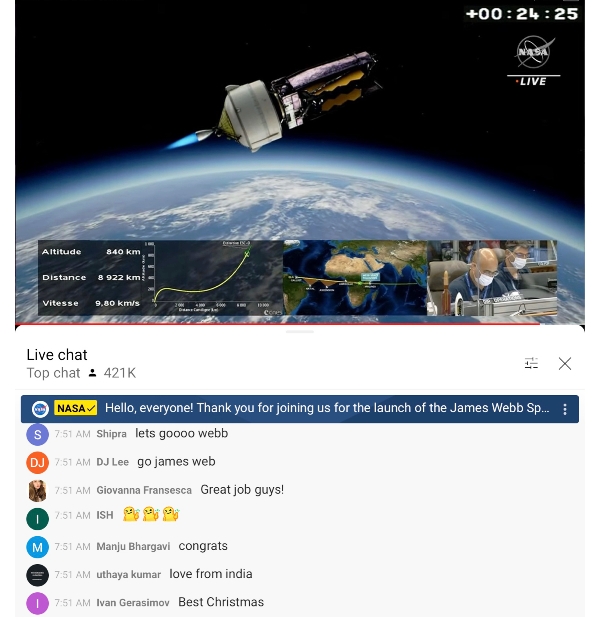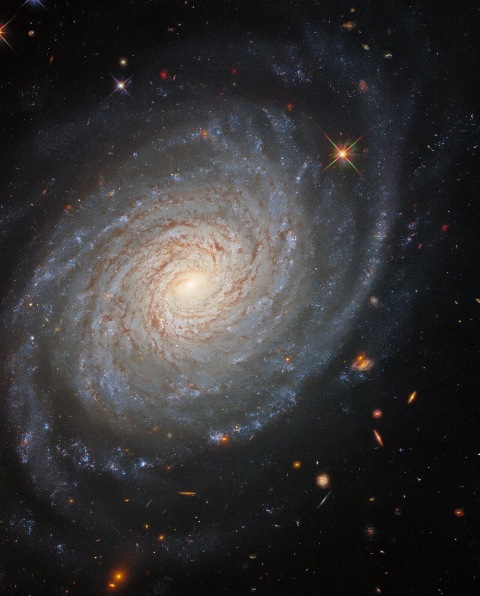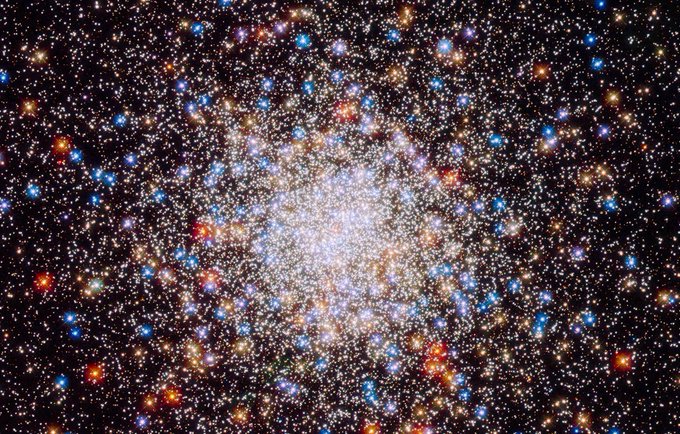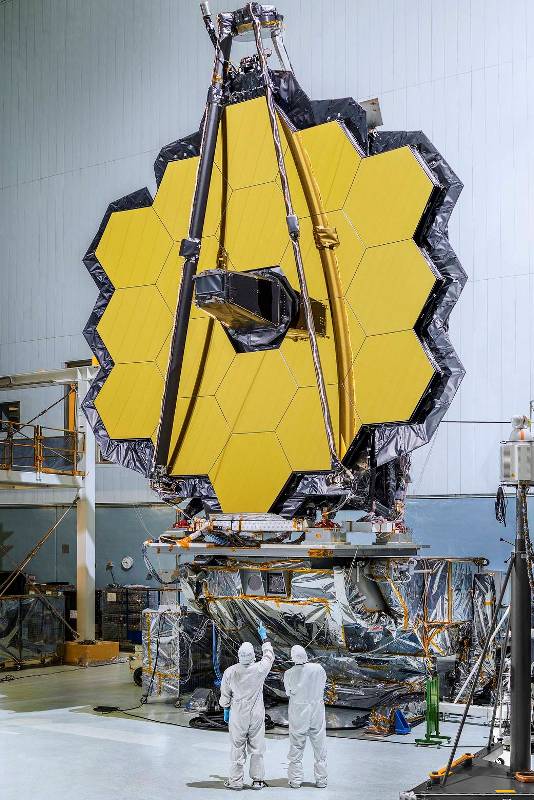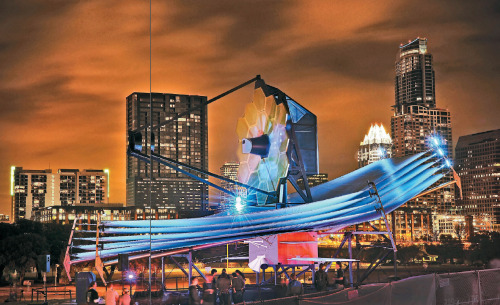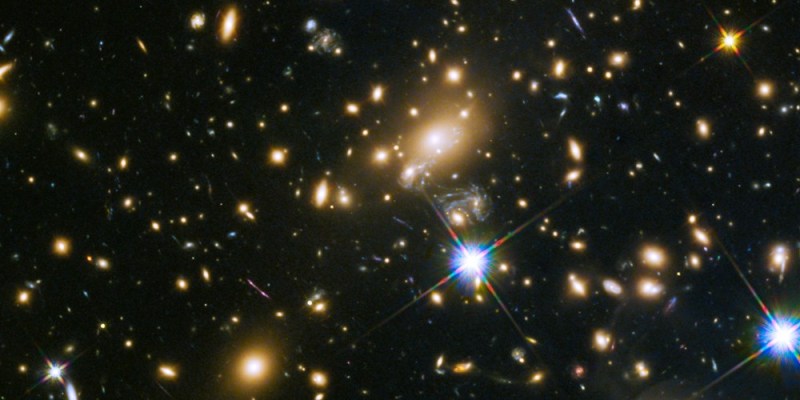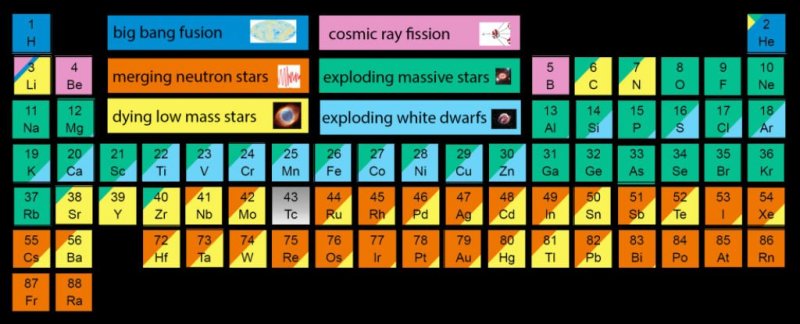Hubble: Difference between revisions
Siterunner (talk | contribs) No edit summary |
Siterunner (talk | contribs) No edit summary |
||
| (82 intermediate revisions by the same user not shown) | |||
| Line 1: | Line 1: | ||
First there was Hubble, then there was Webb | |||
[[File:Webb v Hubble.jpg]] | |||
[http://www.cnet.com/news/happy-25th-birthday-hubble-telescope/ Happy Birthday Hubble (C/NET] | : <big><big><big>'''December 25, 2021: Hubble's successor'''</big></big></big> | ||
:: <big><big><big>'''The James Webb Space Telescope launches !'''</big></big></big> | |||
:::<big><big>[[James webb space telescope]]</big></big> | |||
::[[File:JWST after launch 24.25 seconds.jpg]] | |||
* https://jwst.nasa.gov/content/webbLaunch/index.html | |||
* https://phys.org/news/2021-12-veteran-hubble-webb-space-telescope.html | |||
* https://esahubble.org/images/potw2202a/ | |||
* https://futurism.com/the-byte/hubble-furnace-galaxy | |||
* https://mashable.com/article/nasa-hubble-image-ngc-6380-globular-cluster | |||
* https://www.cnet.com/news/nasa-celebrates-hubbles-return-to-science-with-gorgeous-galaxy-images/ | |||
::1990: Hubble is launched / https://www.youtube.com/watch?v=onYsPY-n-3M | |||
::* https://asd.gsfc.nasa.gov/archive/hubble/overview/hubble_bio.html | |||
:::[[File:Hubble vision shortly before Webb ... 2021 - 2022.JPG]] | |||
:::NASA/Hubble Vision, Before Webb Vision | |||
| |||
<big><big>'''Hubble, You Opened Our Eyes in New Ways to New Worlds, Expanding Our Vision and Our Universe'''</big></big> | |||
:''Hubble has made more than 1.3 million observations since its mission began in 1990 and helped publish more than 15,000 scientific papers.'' | |||
:: ''The Hubble telescope orbits Earth at a speed of about 17,000 mph (27,300kph) in low Earth orbit at about 340 miles in altitude.'' | |||
::::[[File:Hubble - December 2020.jpg]] | |||
''The Hubble telescope is named after Edwin Hubble who was responsible for "the Hubble constant" and is one of the greatest astronomers of all-time.'' | |||
::::::[[File:Edwin Hubble announces existence of other galaxies - 1924.jpg]] | |||
''Hubble's launch and deployment in April 1990 marked the most significant advance in astronomy since Galileo's telescope.'' | |||
''The James Webb Telescope, #JWST, is more specialised than the Hubble. Webb captures the infrared part of the spectrum, light that human eyes cannot see. The #JWST is designed to go beyond what Hubble can do...'' | |||
[https://www.nasa.gov/mission_pages/hubble/main/index.html <big>'''''As the Hubble Mission Comes to an End'''''</big>] | |||
[http://spaceflightnow.com/2015/04/23/fixing-hubbles-blurry-vision/ <big>'''''The Story of Hubble and the Scientists Who Created & Saved It'''''</big>] | |||
:[https://www.theguardian.com/science/2016/oct/13/hubble-telescope-universe-galaxies-astronomy '''''Viewing Two Trillion + Galaxies'''''] | |||
| |||
:::[http://en.m.wikipedia.org/wiki/James_Webb_Space_Telescope <big>'''''After Hubble? The James Webb'''''</big>] | |||
:::[[File:Webb Telescope construction completed-Nov2016.jpg]] | |||
| |||
:::<big><big>'''''Next up, Say Hello to the James Webb Space Telescope!'''''</big></big> | |||
:::<small>* ''http://www.greenpolicy360.net/w/File:Webb_Telescope_construction_completed-Nov2016.jpg''</small> | |||
::::[[File:The James Webb telescope modeled at SXSW 2015.jpg]] | |||
::::<small> '''The James Webb telescope modeled at South by Southwest, 2015''' </small> | |||
::::<font color=blue>○ ○ ○ ○ ○ ○ ○ ○ ○ ○ ○ ○ ○ ○ ○ ○ ○ ○ ○ ○ ○ ○ ○ ○ ○ ○ ○ ○ ○ ○ ○ ○ ○ ○ ○ ○ ○ ○ ○ ○ ○ ○</font> | |||
[[File:MACS J1149.5+223.jpg]] | |||
:<big><big>'''''Hubble Sees as Far as We Have Ever Seen'''''</big></big> | |||
::[https://www.spacetelescope.org/news/heic1807/?lang ''Newfound star is the most distant ever observed''] | |||
<small>• https://www.universal-sci.com/headlines/2019/2/2/astronomers-process-hubbles-deepest-image-to-get-even-more-data-and-show-that-some-galaxies-are-twice-as-big-as-previously-believed</small> | |||
····································································································· | |||
[[File:Seven planets around dwarf star TRAPPIST.png]] | |||
<big><big>'''''NASA/JPL Reveal Largest Batch of Earth-Size, Habitable-Zone Planets Around Single Star'''''</big></big> | |||
* https://www.nasa.gov/press-release/nasa-telescope-reveals-largest-batch-of-earth-size-habitable-zone-planets-around | |||
:* http://mashable.com/2017/02/22/seven-exoplanets-orbiting-trappist-1-star/ | |||
::* http://www.space.com/35803-trappist-1-planets-alien-life.html | |||
* https://exoplanets.nasa.gov/trappist1/ | |||
* https://www.nasa.gov/content/the-search-for-life | |||
''The fact that they transit their star also means that scientists will be able to do plenty of followup observations that will characterize the atmospheres of the worlds thanks to the light shining on them from the star.'' | |||
''All of the planets are far enough from their star that they could conceivably host liquid water on their surfaces, according to the researchers. Four of the worlds in particular are thought to be in the "habitable zone" of the star, which means they could be our best chances for life outside the solar system.'' | |||
''The Hubble Space Telescope characterized the atmospheres of TRAPPIST-1B and TRAPPIST-1C, finding that the two worlds probably aren't encircled by hydrogen and helium rich atmospheres, meaning their atmospheres could resemble our own.'' | |||
''Researchers will be able to get an even better look at these worlds in the future.'' | |||
''NASA's [http://www.space.com/34599-james-webb-space-telescope-facts-you-need-to-know-video.html James Webb Space Telescope (JWST)] — Hubble's telescope successor expected to launch in 2018 — should be able to peer deeply into the atmospheres of alien planets to try to see if they really could be like our own.'' | |||
''The JWST might be able to pick out oxygen, carbon dioxide, methane and other molecules in exoplanet atmospheres to find any [https://en.wikipedia.org/wiki/Biosignature biosignatures] that might be present.'' | |||
<big><big>''Hubble's 25th Anniversary''</big></big> | |||
[http://www.cnet.com/news/happy-25th-birthday-hubble-telescope/ ''Happy Birthday Hubble (C/NET)''] | |||
[http://www.nytimes.com/interactive/2015/04/23/science/space/unforgettable-hubble-space-telescope-photos.html ''Unforgettable Hubble (NYT)''] | |||
[http://www.greenpolicy360.net/w/File:Hubble_carina_star_births.jpg ''Turning Black-and-White Images Into Masterpieces (National Geographic)''] | |||
○ | |||
[https://orionmagazine.org/article/window-of-possibility/'''''Window of Possibility'''''] | |||
''by Anthony Doerr'' | |||
''The following article is courtesy of Orion Magazine'' - [https://subscribe.pcspublink.com/Sub/Subscribeform2.aspx?t=JBP8&p=ORIN&tr=TopNav ''Subscribe to Orion''] | |||
'''''Hubble Ultra Deep Field''''' | |||
''We call our galaxy the Milky Way. There are at least 100 billion stars in it and our sun is one of those. A hundred billion is a big number, and humans are not evolved to appreciate numbers like that, but here’s a try: If you had a bucket with a thousand marbles in it, you would need to procure 999,999 more of those buckets to get a billion marbles. Then you’d have to repeat the process a hundred times to get as many marbles as there are stars in our galaxy.'' | |||
''So. The Earth is massive enough to hold all of our cities and oceans and creatures in the sway of its gravity. And the sun is massive enough to hold the Earth in the sway of its gravity. But the sun itself is merely a mote in the sway of the gravity of the Milky Way, at the center of which is a vast, concentrated bar of stars, around which the sun swings (carrying along Earth, Mars, Jupiter, Saturn, etc.) every 230 million years or so. Our sun isn’t anywhere near the center; it’s way out on one of the galaxy’s minor arms. We live beyond the suburbs of the Milky Way. We live in Nowheresville.'' | |||
''But still, we are in the Milky Way. And that’s a big deal, right? The Milky Way is at least a major galaxy, right?'' | |||
''Not really. Spiral-shaped, toothpick-shaped, sombrero-shaped — in the visible universe, at any given moment, there are hundreds of thousands of millions of galaxies. Maybe as many as 125 billion. There very well may be more galaxies in the universe than there are stars in the Milky Way.'' | |||
''So. Let’s say there are 100 billion stars in our galaxy. And let’s say there are 100 billion galaxies in our universe. At any given moment, then, assuming ultra-massive and dwarf galaxies average each other out, there might be 10,000,000,000,000,000,000,000 stars in the universe. That’s 1.0 X 10 to the twenty-second power. That’s 10 sextillion.'' | |||
''Here’s a way of looking at it: there are enough stars in the universe that if everybody on Earth were charged with naming his or her share, we’d each get to name a trillion and a half of them.'' | |||
''Even that number is still impossibly hard to comprehend — if you named a star every time your heart beat for your whole life, you’d have to live about 375 lifetimes to name your share.'' | |||
○ | ○ | ||
<big><big>'''Through Our Digital Devices We're Living 'Mediated Lives'</big></big> | |||
'''Say 'Hi' to GN-z11''' | |||
[https://en.wikipedia.org/wiki/GN-z11 '''GN-z11 is the oldest and most distant known galaxy yet identified in the observable universe'''] | |||
* https://www.seeker.com/hubble-spies-most-distant-oldest-galaxy-ever-1770971428.html | |||
''A few exhausted photons of light from [https://en.wikipedia.org/wiki/GN-z11 '''GN-z11'''] dropped on a photoelectric detector aboard a satellite orbiting Earth, produced a tiny electrical current that was translated into 0s and 1s, which were beamed to Earth in a radio wave. That information was then processed in data centers in New Mexico and Maryland and eventually landed on Professor Oesch’s computer screen in Geneva. These days, professional astronomers rarely look at the sky through the lens of a telescope. They sit at computer screens.'' | |||
''But not only astronomers. Many of us invest hours each day staring at the screens of our televisions and computers and smartphones. Seldom do we go outside on a clear night, away from the lights of the city, and gaze at the dark starry sky, or take walks in the woods unaccompanied by our digital devices. Most of the minutes and hours of each day we spend in temperature-controlled structures of wood, concrete, and steel. With all of its success, our technology has greatly diminished our direct experience with nature. We live mediated lives. We have created a natureless world...'' | |||
''It was not always this way. For more than 99 percent of our history as humans, we lived close to nature. We lived in the open. The first house with a roof appeared only 5,000 years ago. Television less than a century ago. Internet-connected phones only about 30 years ago. Over the large majority of our 2-million-year evolutionary history, Darwinian forces molded our brains to find kinship with nature, what the biologist E. O. Wilson called “biophilia.” That kinship had survival benefit. Habitat selection, foraging for food, reading the signs of upcoming storms all would have favored a deep affinity with nature. Social psychologists have documented that such sensitivities are still present in our psyches today. Further psychological and physiological studies have shown that more time spent in nature increases happiness and well-being; less time increases stress and anxiety. Thus, there is a profound disconnect between the natureless environment we have created and the “natural” affections of our minds. In effect, we live in two worlds: a world in close contact with nature, buried deep in our ancestral brains, and a natureless world of the digital screen and constructed environment, fashioned from our technology and intellectual achievements. We are at war with our ancestral selves. The cost of this war is only now becoming apparent.'' | |||
* https://www.theatlantic.com/technology/archive/2022/01/machine-garden-natureless-world/621268/ | |||
<font color=blue>○ ○ ○ ○ ○ ○ ○ ○ ○ ○ ○ ○ ○ ○ ○ ○ ○ ○ ○ ○ ○ ○</font> | |||
; <big><big>[http://www.greenpolicy360.net/w/File:Hubble_Ultra_Deep_Field_2014-20140603_NASA-HS201427a-.jpg ''Hubble Ultra Deep Field'']</big></big> | |||
''Last year, a handful of astronomers met in London to vote on the top ten images taken by the Hubble Telescope in its sixteen years in operation. They chose some beauties: the Cat’s Eye Nebula, the Sombrero Galaxy, the Hourglass Nebula. But conspicuously missing from their list was the [http://en.wikipedia.org/wiki/Hubble_Ultra-Deep_Field Hubble Ultra Deep Field image]. It is, I believe, the most incredible photograph ever taken.'' | |||
''In 2003, Hubble astronomers chose a random wedge of sky just below the constellation Orion and, during four hundred orbits of the Earth, over the course of several months, took a photograph with a million-second-long exposure. It was something like peering through an eight-foot soda straw with one big, superhuman eye at the same wedge of space for eleven straight nights.'' | |||
''What they found there was breathtaking: a shard of the early universe that contains a bewildering array of galaxies and pre-galactic lumps. Scrolling through it is eerily similar to peering at a drop of pond water through a microscope: one expects the galaxies to start squirming like paramecia. It bewilders and disorients; the dark patches swarm with questions. If you peered into just one of its black corners, took an Ultra Deep Field of the Ultra Deep Field, would you see as much all over again?'' | |||
''What the Ultra Deep Field image ultimately offers is a singular glimpse at ourselves. Like Copernicus’s On the Revolutions of the Celestial Spheres, it resets our understanding of who and what we are.'' | |||
''As of early April 2007, astronomers had found 204 planets outside our solar system. They seem to be everywhere we look. Chances are, many, many stars have planets or systems of planets swinging around them. What if most suns have solar systems? | |||
If our sun is one in 10 sextillion, could our Earth be one in 10 sextillion as well? Or the Earth might be one — just one, the only one, the one. Either way, the circumstances are mind-boggling.'' | |||
''The Hubble Ultra Deep Field is an infinitesimally slender core-sample drilled out of the universe. And yet inside it is enough vastness to do violence to a person’s common sense. How can the window of possibility be so unfathomably large?'' | |||
''Take yourself out to a field some evening after everyone else is asleep. Listen to the migrant birds whisking past in the dark; listen to the creaking and settling of the world. Think about the teeming, microscopic worlds beneath your shoes — the continents of soil, the galaxies of bacteria. Then lift your face up.'' | |||
''The night sky is the coolest Advent calendar imaginable: it is composed of an infinite number of doors. Open one and find ten thousand galaxies hiding behind it, streaming away at hundreds of miles per second. Open another, and another. You gaze up into history; you stare into the limits of your own understanding. The past flies toward you at the speed of light. Why are you here? Why are the stars there? Is it even remotely possible that our one, tiny, eggshell world is the only one encrusted with life?'' | |||
''The Hubble Ultra Deep Field image should be in every classroom in the world. It should be on the president’s desk. It should probably be in every church, too.'' | |||
''“To sense that behind anything that can be experienced,” Einstein once said, “there is a something that our mind cannot grasp and whose beauty and sublimity reaches us only indirectly and as a feeble reflection, this is religiousness.”'' | |||
''Whatever we believe in — God, children, nationhood — nothing can be more important than to take a moment every now and then and accept the invitation of the sky: to leave the confines of ourselves and fly off into the hugeness of the universe, to disappear into the inexplicable, the implacable, the reflection of that something our minds cannot grasp.'' | |||
-- ''Anthony Doerr'' | |||
○ | |||
[[File:Starstuff we are.jpg]] | |||
<big>'''We are made of stars...'''</big> | |||
* https://www.greenpolicy360.net/w/File:Creation-of.jpg | |||
* https://www.greenpolicy360.net/w/File:Starstuff_we_are.jpg | |||
* https://www.greenpolicy360.net/w/File:We_are_made_of_star_stuff_--_carl_sagan.jpg | |||
························································ | |||
[https://www.greenpolicy360.net/w/File:Hubble_STS-125_May_17_EVA.jpg '''Hubble is launched into Space'''] | |||
[https://www.greenpolicy360.net/w/File:Hubble_fix_348557main_fd6-signal_full.jpg '''The Hubble Fix'''] | |||
- | [[File:Hubble - Wikipedia.jpeg]] | ||
Wikipedia / Open Source Share | |||
[[ | [[Category:Exoplanets]] | ||
[[Category:NASA]] | |||
[[Category:Ecology Studies]] | |||
[[Category:Origins of Life]] | |||
[[Category:Planet Citizens, Planet Scientists]] | |||
[[Category:Planetary Science]] | |||
[[Category:Space Science and Space Physics]] | |||
[[Category:Stardust]] | |||
Latest revision as of 21:03, 2 October 2024
First there was Hubble, then there was Webb
- December 25, 2021: Hubble's successor
- The James Webb Space Telescope launches !
- 1990: Hubble is launched / https://www.youtube.com/watch?v=onYsPY-n-3M
- NASA/Hubble Vision, Before Webb Vision
Hubble, You Opened Our Eyes in New Ways to New Worlds, Expanding Our Vision and Our Universe
- Hubble has made more than 1.3 million observations since its mission began in 1990 and helped publish more than 15,000 scientific papers.
- The Hubble telescope orbits Earth at a speed of about 17,000 mph (27,300kph) in low Earth orbit at about 340 miles in altitude.
The Hubble telescope is named after Edwin Hubble who was responsible for "the Hubble constant" and is one of the greatest astronomers of all-time.
Hubble's launch and deployment in April 1990 marked the most significant advance in astronomy since Galileo's telescope.
The James Webb Telescope, #JWST, is more specialised than the Hubble. Webb captures the infrared part of the spectrum, light that human eyes cannot see. The #JWST is designed to go beyond what Hubble can do...
As the Hubble Mission Comes to an End
The Story of Hubble and the Scientists Who Created & Saved It
- Next up, Say Hello to the James Webb Space Telescope!
- The James Webb telescope modeled at South by Southwest, 2015
- ○ ○ ○ ○ ○ ○ ○ ○ ○ ○ ○ ○ ○ ○ ○ ○ ○ ○ ○ ○ ○ ○ ○ ○ ○ ○ ○ ○ ○ ○ ○ ○ ○ ○ ○ ○ ○ ○ ○ ○ ○ ○
- Hubble Sees as Far as We Have Ever Seen
·····································································································
NASA/JPL Reveal Largest Batch of Earth-Size, Habitable-Zone Planets Around Single Star
The fact that they transit their star also means that scientists will be able to do plenty of followup observations that will characterize the atmospheres of the worlds thanks to the light shining on them from the star.
All of the planets are far enough from their star that they could conceivably host liquid water on their surfaces, according to the researchers. Four of the worlds in particular are thought to be in the "habitable zone" of the star, which means they could be our best chances for life outside the solar system.
The Hubble Space Telescope characterized the atmospheres of TRAPPIST-1B and TRAPPIST-1C, finding that the two worlds probably aren't encircled by hydrogen and helium rich atmospheres, meaning their atmospheres could resemble our own.
Researchers will be able to get an even better look at these worlds in the future.
NASA's James Webb Space Telescope (JWST) — Hubble's telescope successor expected to launch in 2018 — should be able to peer deeply into the atmospheres of alien planets to try to see if they really could be like our own.
The JWST might be able to pick out oxygen, carbon dioxide, methane and other molecules in exoplanet atmospheres to find any biosignatures that might be present.
Hubble's 25th Anniversary
Turning Black-and-White Images Into Masterpieces (National Geographic)
○
by Anthony Doerr
The following article is courtesy of Orion Magazine - Subscribe to Orion
Hubble Ultra Deep Field
We call our galaxy the Milky Way. There are at least 100 billion stars in it and our sun is one of those. A hundred billion is a big number, and humans are not evolved to appreciate numbers like that, but here’s a try: If you had a bucket with a thousand marbles in it, you would need to procure 999,999 more of those buckets to get a billion marbles. Then you’d have to repeat the process a hundred times to get as many marbles as there are stars in our galaxy.
So. The Earth is massive enough to hold all of our cities and oceans and creatures in the sway of its gravity. And the sun is massive enough to hold the Earth in the sway of its gravity. But the sun itself is merely a mote in the sway of the gravity of the Milky Way, at the center of which is a vast, concentrated bar of stars, around which the sun swings (carrying along Earth, Mars, Jupiter, Saturn, etc.) every 230 million years or so. Our sun isn’t anywhere near the center; it’s way out on one of the galaxy’s minor arms. We live beyond the suburbs of the Milky Way. We live in Nowheresville.
But still, we are in the Milky Way. And that’s a big deal, right? The Milky Way is at least a major galaxy, right?
Not really. Spiral-shaped, toothpick-shaped, sombrero-shaped — in the visible universe, at any given moment, there are hundreds of thousands of millions of galaxies. Maybe as many as 125 billion. There very well may be more galaxies in the universe than there are stars in the Milky Way.
So. Let’s say there are 100 billion stars in our galaxy. And let’s say there are 100 billion galaxies in our universe. At any given moment, then, assuming ultra-massive and dwarf galaxies average each other out, there might be 10,000,000,000,000,000,000,000 stars in the universe. That’s 1.0 X 10 to the twenty-second power. That’s 10 sextillion.
Here’s a way of looking at it: there are enough stars in the universe that if everybody on Earth were charged with naming his or her share, we’d each get to name a trillion and a half of them.
Even that number is still impossibly hard to comprehend — if you named a star every time your heart beat for your whole life, you’d have to live about 375 lifetimes to name your share.
○
Through Our Digital Devices We're Living 'Mediated Lives'
Say 'Hi' to GN-z11
GN-z11 is the oldest and most distant known galaxy yet identified in the observable universe
A few exhausted photons of light from GN-z11 dropped on a photoelectric detector aboard a satellite orbiting Earth, produced a tiny electrical current that was translated into 0s and 1s, which were beamed to Earth in a radio wave. That information was then processed in data centers in New Mexico and Maryland and eventually landed on Professor Oesch’s computer screen in Geneva. These days, professional astronomers rarely look at the sky through the lens of a telescope. They sit at computer screens.
But not only astronomers. Many of us invest hours each day staring at the screens of our televisions and computers and smartphones. Seldom do we go outside on a clear night, away from the lights of the city, and gaze at the dark starry sky, or take walks in the woods unaccompanied by our digital devices. Most of the minutes and hours of each day we spend in temperature-controlled structures of wood, concrete, and steel. With all of its success, our technology has greatly diminished our direct experience with nature. We live mediated lives. We have created a natureless world...
It was not always this way. For more than 99 percent of our history as humans, we lived close to nature. We lived in the open. The first house with a roof appeared only 5,000 years ago. Television less than a century ago. Internet-connected phones only about 30 years ago. Over the large majority of our 2-million-year evolutionary history, Darwinian forces molded our brains to find kinship with nature, what the biologist E. O. Wilson called “biophilia.” That kinship had survival benefit. Habitat selection, foraging for food, reading the signs of upcoming storms all would have favored a deep affinity with nature. Social psychologists have documented that such sensitivities are still present in our psyches today. Further psychological and physiological studies have shown that more time spent in nature increases happiness and well-being; less time increases stress and anxiety. Thus, there is a profound disconnect between the natureless environment we have created and the “natural” affections of our minds. In effect, we live in two worlds: a world in close contact with nature, buried deep in our ancestral brains, and a natureless world of the digital screen and constructed environment, fashioned from our technology and intellectual achievements. We are at war with our ancestral selves. The cost of this war is only now becoming apparent.
○ ○ ○ ○ ○ ○ ○ ○ ○ ○ ○ ○ ○ ○ ○ ○ ○ ○ ○ ○ ○ ○
Last year, a handful of astronomers met in London to vote on the top ten images taken by the Hubble Telescope in its sixteen years in operation. They chose some beauties: the Cat’s Eye Nebula, the Sombrero Galaxy, the Hourglass Nebula. But conspicuously missing from their list was the Hubble Ultra Deep Field image. It is, I believe, the most incredible photograph ever taken.
In 2003, Hubble astronomers chose a random wedge of sky just below the constellation Orion and, during four hundred orbits of the Earth, over the course of several months, took a photograph with a million-second-long exposure. It was something like peering through an eight-foot soda straw with one big, superhuman eye at the same wedge of space for eleven straight nights.
What they found there was breathtaking: a shard of the early universe that contains a bewildering array of galaxies and pre-galactic lumps. Scrolling through it is eerily similar to peering at a drop of pond water through a microscope: one expects the galaxies to start squirming like paramecia. It bewilders and disorients; the dark patches swarm with questions. If you peered into just one of its black corners, took an Ultra Deep Field of the Ultra Deep Field, would you see as much all over again?
What the Ultra Deep Field image ultimately offers is a singular glimpse at ourselves. Like Copernicus’s On the Revolutions of the Celestial Spheres, it resets our understanding of who and what we are.
As of early April 2007, astronomers had found 204 planets outside our solar system. They seem to be everywhere we look. Chances are, many, many stars have planets or systems of planets swinging around them. What if most suns have solar systems? If our sun is one in 10 sextillion, could our Earth be one in 10 sextillion as well? Or the Earth might be one — just one, the only one, the one. Either way, the circumstances are mind-boggling.
The Hubble Ultra Deep Field is an infinitesimally slender core-sample drilled out of the universe. And yet inside it is enough vastness to do violence to a person’s common sense. How can the window of possibility be so unfathomably large?
Take yourself out to a field some evening after everyone else is asleep. Listen to the migrant birds whisking past in the dark; listen to the creaking and settling of the world. Think about the teeming, microscopic worlds beneath your shoes — the continents of soil, the galaxies of bacteria. Then lift your face up.
The night sky is the coolest Advent calendar imaginable: it is composed of an infinite number of doors. Open one and find ten thousand galaxies hiding behind it, streaming away at hundreds of miles per second. Open another, and another. You gaze up into history; you stare into the limits of your own understanding. The past flies toward you at the speed of light. Why are you here? Why are the stars there? Is it even remotely possible that our one, tiny, eggshell world is the only one encrusted with life?
The Hubble Ultra Deep Field image should be in every classroom in the world. It should be on the president’s desk. It should probably be in every church, too.
“To sense that behind anything that can be experienced,” Einstein once said, “there is a something that our mind cannot grasp and whose beauty and sublimity reaches us only indirectly and as a feeble reflection, this is religiousness.”
Whatever we believe in — God, children, nationhood — nothing can be more important than to take a moment every now and then and accept the invitation of the sky: to leave the confines of ourselves and fly off into the hugeness of the universe, to disappear into the inexplicable, the implacable, the reflection of that something our minds cannot grasp.
-- Anthony Doerr
○
We are made of stars...
························································
Wikipedia / Open Source Share

